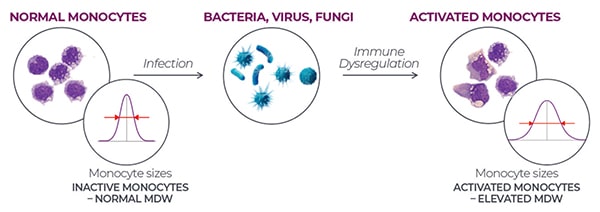Anne Paxton
July 2023—When Butler Health System in early 2020 installed the Beckman Coulter DxA 5000 automation line, its hospitals were among the first in the country to do so. At the same time, Butler went live with the DxH 900 hematology analyzer. The hope was that the new automation would ease the laboratory’s labor shortage, says Robert Patterson, MD, director of pathology and laboratory medicine for the Butler system, based in Butler, Pa., and as of this year part of the Independence Health System.
By 2022, the new automation was helping in another way: by reducing the time to sepsis diagnosis and patient management.
The Food and Drug Administration in 2019 cleared the monocyte distribution width sepsis biomarker as a reportable parameter included in the leukocyte five-part differential analysis. After using the MDW for 10 months, starting last year, Dr. Patterson can report that time to diagnosis and appropriate therapy is shorter. He shared his lab’s findings this spring at the Executive War College and in a recent interview with CAP TODAY.
MDW is the calculated standard deviation of the measured monocyte volumes. A normal MDW would be the result if monocyte sizes indicated inactive monocytes. But when an infection—whether bacterial, viral, or fungal—leads to immune dysregulation that decreases the relative number of monocytes, there is a subsequent increase in the variability of monocyte sizes and an elevated MDW, which may indicate sepsis is a possibility.
One of the most important changes in diagnosing sepsis in the past 10 years has been the evolution of criteria for clinically suspecting that a bacteremia patient has sepsis, Dr. Patterson says. “On the laboratory side, there have been molecular advancements with some of these phenotypic panels. We’re able to detect a certain group of organisms, some of which also have resistance genes attached to them. And those can be helpful. But you still need to have an antibiotic.” And determining the right one is not simple. “The reason is that in the Gram-negative organisms, there are so many possible mutations. And as soon as a manufacturer or vendor patents one certain panel with a set of genes on it, it’s obsolete, so it isn’t that helpful.”

Dr. Patterson
Dr. Patterson and Butler’s emergency department head and infectious diseases director joined as a cross-functional team to consider how they might be able to address the gap by using MDW—but carefully. “MDW is elevated in bacterial sepsis. It also can be elevated in viral sepsis [viremia] or with fungal systemic infections [fungemia], as well as with some noninfectious causes such as pregnancy. Those are other possibilities,” Dr. Patterson notes. The team created an algorithm using both MDW and WBC, and they decided to include abnormal WBC (high or low), rather than just an elevated WBC, as an additional criterion for concluding there is a substantial risk of sepsis. This was done because there are outliers—the elderly in particular. “When they get sepsis, their WBC often goes down,” he says.
Once an MDW hits a value of 20, the laboratory sends a blood sample to its T2 Biosystems instrument, which has a bacterial panel that uses magnetic resonance to detect organisms within three to five hours. Two other features of the T2 panel make it valuable, Dr. Patterson says. “One is that it is more sensitive than a blood culture. And we’ve had cases where we couldn’t grow anything enough to identify it but the T2 did identify it. The other is that the T2 is not affected by antibiotics.”
Setting out with an MDW of 20 as a critical value at first created confusion among clinicians. “Things other than bacterial infection can cause the MDW to be high. If you keep telling them that this is critical and it doesn’t turn into anything, they’re going to stop paying attention to it.” To prevent this, the laboratory focused on education.
The hospitals used the MDW only in the emergency department to start because that’s how it was FDA cleared, Dr. Patterson says. Some ED patients would be admitted. “We wanted the doctors who were going to be handling them, once they left the ED, to know why some of the decisions were made,” so hospitalists and intensivists were educated too. For other clinicians, ”even though the MDW is being run on everybody, it’s being masked by the IT system” if it wasn’t ordered.
Clinicians have found the MDW useful because it starts falling when a treatment is effective, Dr. Patterson says. That was seen in a European study, which showed that, with patients who were identified as septic, “if their MDW started to decrease with treatment, those were the survivors.” The nonsurvivors were those in whom the MDW remained the same (Hausfater P, et al. Crit Care. 2021;25[1]:227).

Since MDW is separate from the CBC, “there was an analytical and clinical validation before the FDA clearance. There are numerous publications validating MDW’s use with patients who presented to the ED and had a CBC ordered. Together,” Dr. Vucetic says, “results of MDW and WBC tests outperform each test’s performance alone in terms of indicating the risk of sepsis in the next 12 hours.”
There is a small fee associated with the use of the MDW, says Jeff Tarmy, the company’s director of global publications and media. “But the fee is nominal when you consider all the benefits on the other side. And Beckman is the only company that offers this parameter,” he says.
There is more than one biomarker that is elevated in bacterial sepsis, Dr. Patterson notes, but the MDW parameter offers advantages. Since a CBC order is almost automatic for patients arriving in the emergency department and MDW is automatically performed as part of the CBC, there is no need to proactively order it. “Our thinking was that it could be particularly useful in the ED setting, because if the clinical criteria for sepsis weren’t met and if they’re not already thinking about sepsis and they saw the MDW was high, it would make them think about sepsis” and consider it a possibility in the differential diagnosis.
He and his colleagues don’t want clinicians to think an elevated MDW and an abnormal WBC automatically mean sepsis. But the patient is at a substantial risk for developing sepsis. “Normally, you draw blood cultures and you have to incubate them and that takes a while; it can be two or three days but at least overnight or 24 hours. Then, when your instrument alerts you that it’s positive, you take some of that infected blood and do a Gram stain and work it up and do more agar plates or a phenotypic platform to determine what the bacterium is.”
The T2 Biosystems panel instead uses magnetic resonance to detect the organism in the blood without culturing. “In our hands, it takes about 4.2 hours to get that result,” Dr. Patterson says. The weakness of the T2 at this point is that it detects only five organisms: Enterococcus faecium, Staphylococcus aureus, Klebsiella pneumoniae, Pseudomonas aeruginosa, and Escherichia coli. That covers about 70 percent of the sepsis cases. But “since we’re drawing the blood culture at the same time, you’re not going to miss the other organisms. You just won’t get them as fast.”
 CAP TODAY Pathology/Laboratory Medicine/Laboratory Management
CAP TODAY Pathology/Laboratory Medicine/Laboratory Management
